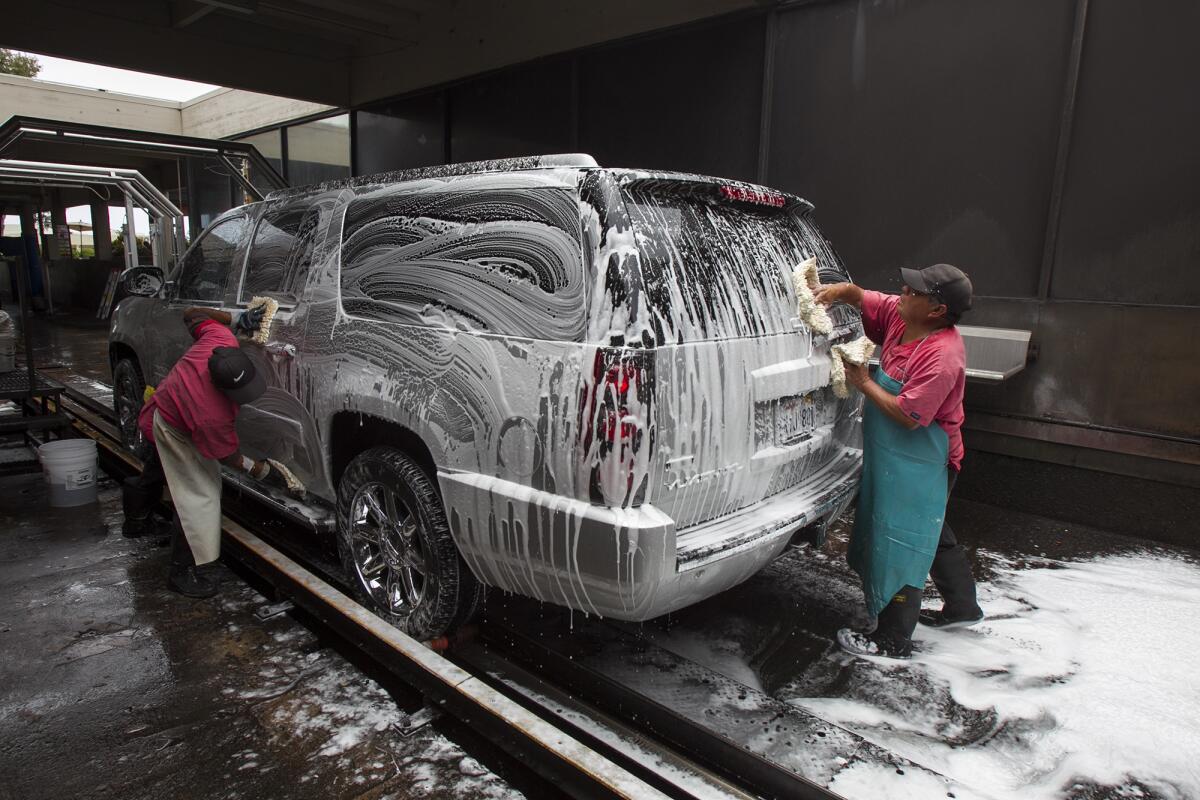Conserving water at the car wash

Employees hand-wash a car at Newport Beach Car Wash. Using a car wash instead of doing it yourself can help save water.
Washing your car at home may save a trip to the car wash, as well as a few bucks, but there’s one resource the practice does not conserve: water.
A driveway car wash can take more than 100 gallons of water, according to one study, whereas more-modern car washes equipped with recirculating water systems can use less than half that amount.
And in Newport Beach, which has been asked by the state to reduce water use by 28%, City Hall is urging people to find ways to conserve. That can be a challenge in a town known for often-sparkling tony rides, where pride of vehicle ownership sometimes includes at-home sprucing.
“More often than not, I see a river of water running down my street because neighbors are washing their cars,” said Newport Beach resident Allen Drucker, 66. “We’re letting our lawns die to conserve water, but we’re not willing to take our cars to the car wash and do the same?”
Drucker goes to The Car Spa on West Coast Highway in Newport Beach once a week. At the full-service car wash, employees hand-wash his car as it moves through a tunnel.
A service package of hand-washing, vacuuming and tire dressing costs $17.95, but prices are lower for frequent users.
That’s certainly a higher cost than doing it at home, but each wash at The Car Spa uses only 16 to 18 gallons of water, location manager Alu Almeida said.
By contrast, International Carwash Assn. CEO Eric Wulf estimated that 8 to 10 gallons of water leave a household hose every minute it is in use.
*
Driveway car washes
Newport Beach does not ban vehicle washing in home driveways. However, under the municipal code on water conservation, only a bucket and a hose with a shut-off nozzle may be used.
According to George Murdoch, the city’s general manager for utilities, the bucket may be of any size and can be filled with as much water as the resident desires.
“People are allowed to wash in their driveways, but they’re not allowed to use water in a wasteful manner,” Murdoch said. “We just need to be mindful of whether we’re using water or wasting it. If the hose was left running, that’s wasteful.”
Newport Beach resident Meredith Adkins, 33, said her husband washes their car in the driveway “once in a while,” but they will still take it to Newport Beach Car Wash at Newport Center every couple of months.
When the full-service car wash opened in January 2014, the business also completed a certification with WaterSavers, a conservation program administered by the International Carwash Assn. As a participant, Newport Beach Car Wash guarantees to use less than 40 gallons of fresh water per car wash.
However, customers are not always aware of the certification.
“I had no idea they even recycled their water,” Adkins said. “I assume they’re doing their part to conserve water so, yes, I’ll take it here again.”
Adkins said that despite the price, she would still take her car to a car wash in the interest of saving water.
The Silver Package, with hand-washing, costs $19.99. The Platinum Package, which includes interior and exterior cleaning, costs $27.99.
*
How water recycling works
Newport Beach Car Wash water goes through a specific cycle within its recirculating system each day.
As a car is pulled onto a conveyor belt, and into a tunnel, arcs spray water and soap. The water that is sprayed then falls under the conveyor belt and is collected in an underground clarifier.
While in the clarifier, the water undergoes treatment for reuse. The next stop is the 15,000-gallon underground holding tank.
As the water moves through the tank, a standard filtration system catches dirt, grime and other materials.
At this point, water is ready to move through the recirculating pump, which will take it back through the tunnel arcs. It is now sanitary enough to be used to clean the next car.
Newport Beach Car Wash cleans out the holding tank every six months.
Water used at within The Car Spa on West Coast Highway goes through a similar process.
Its holding tank carries around 3,500 gallons and is split into three different tanks. The water travels from one tank to the next, filtering out whatever sludge carried along with it. Once the water hits the third tank, it is clean and ready to be pumped back into the arcs.
*
Other water-saving options
Besides the full-service locations, other types of car washes may also save water compared with washing a car in the driveway.
Water conservation research conducted by the Lower Colorado River Authority shows that a typical self-serve car wash can use 17 gallons per vehicle. Those are the places where customers drive in, feed quarters into a slot and wash the cars themselves.
An in-bay automatic car wash, which are washes connected to gas stations or convenience stores, usually use around 20 to 30 gallons per vehicle, according to the authority.
During this study, the authority also attached a meter to measure the amount of gallons used by a hose while washing a car in the driveway. The result: 116 gallons.
For Drucker, he said he hopes that other residents will see the contrast between water wasted at home and water saved at the car wash.
“There are necessities where we need to use water, like washing your clothes, dishes or food,” he said. “There aren’t really alternatives to those things. However, in this case of washing your car, there is a viable and attractive alternative – taking it to a carwash.”